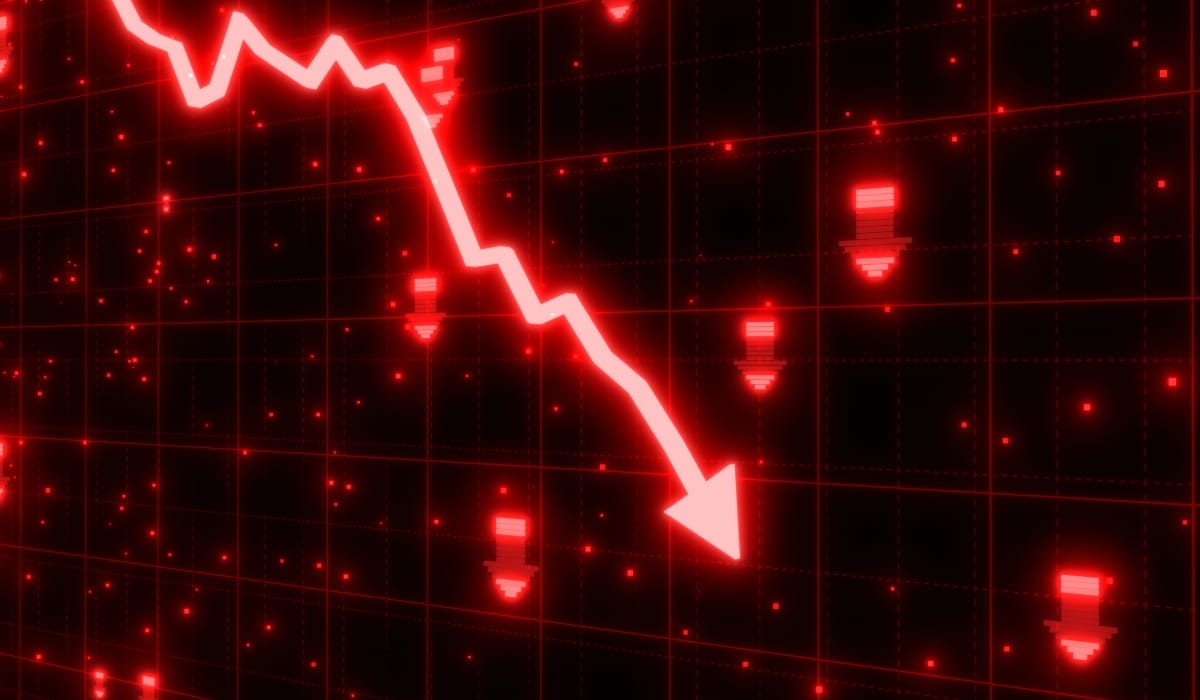What Is a Bear Trap in Crypto Trading?
Many crypto traders have fallen for bear traps because of how tricky they can be. Find out what is a bear trap and how to avoid being a victim.

A bear trap is any situation in the market in which the price of an asset - either a stock or cryptocurrency - appears to fall significantly enough to make traders think a bearish trend has begun. It also convinces them to sell or open short positions with the view of prices falling. This is only a temporary decline, and the price soon changes direction to head upwards sharply, catching those who were expecting a downtrend.
Bear traps are most common within unstable markets, such as cryptocurrency and stock markets, in which the prices can easily fluctuate so unpredictably and within such short periods. Traders who fall into a bear trap experience losses when the market actually moves against their bearish positions. These traps are hard to define in real time; thus, they become dangerous for both novice and experienced traders. In this article, we will discuss everything about bear traps and how to avoid them.
Understanding the Basic Characteristics of Bear Traps
To understand bear traps, you have to look into the basic characteristics the market shows before and after they occur. They include the following:
False Break of Support
The classic definition of a bear trap starts when the price of an asset breaks lower through a key support level - an area of price where the asset has traditionally found buying interest. A trader is then led to believe that the price will continue to slide lower and perhaps sell their position or open a short sale. The break, however, is fleeting, and the price subsequently turns higher.
Short Covering Rallies
After traders have positioned themselves with shorts, anticipating further losses, the market reverses. In this instance, a short covering rally follows when a trader selling short has to buy back an instrument to cover their positions and so, drive the price even higher.
Manipulative Movements
Sometimes, the big players of the market deliberately create up and down moves to push the price down, which would attract selling, and then immediately reverse the price once enough traders have been attracted to bearish positions.
Mechanics of a Bear Trap
A bear trap is triggered by the market conditions and is usually manipulated by big players (whales) to make substantial profits. In these tricky market conditions, you may think something big is on a downtrend, and then, all of a sudden, the market reverses against your expectations. The following key mechanics create a bear trap:
False Breakout below Key Support Levels
Price momentarily breaks below the key support level, perhaps triggering some selling or shorting. In this case, the breakout is false since the price recovers in a sufficiently short time frame to trap those traders who bet on a further downtrend.
The Trap Manipulated by Large Players
Whales create a fall in price that is not true in the marketplace, beyond their levels of support, so as to force the smaller traders to liquidate their positions. Once the small traders liquidate, the whales buy back cheaper and the market reverses.
Short Selling and Short Squeeze
Traders sell-short the assets when expecting market declines. On reversal, they have to repurchase such positions at higher prices, further driving up the price, hence deeper the trap.
Market Psychology and Emotional Response
Fears, greed, and herd mentality are the prime psychological items that make a trader decide in emotional directions since selling their assets in panic after watching the prices drop without knowing that it might be a bear trap.
Volume Dynamics and Market Liquidity
Bear traps often come about when volume is low, and the drop of price seems to be much worse than it actually is. If the market were to flip, it would be shown that the downtrend was indeed false, with high volume.
Support and Resistance Level Manipulation
A bear trap is said to occur whenever the price breaks below support and then reverses into a break above the same level, thus trapping the sell-side betters.
Role of Market News and Sentiment
Sometimes, negative news can be the cause of the price fall. Traders jump into shorting or selling too early before the price starts recovering after the change in sentiment. Knowing these processes will help you reduce your risk and not get misled by these bogus signals. If you understand how cryptos gain value, you’ll get why sudden news, whether real or fake, can seriously affect the prices of your assets.

How to Identify Bear Traps
In the real world, it is quite difficult to identify the bear trap in the highly volatile crypto markets. One of the best ways to avoid falling into a bear trap is basically to understand the indications and patterns that best identify them. The identification of an actual bear trap requires the right mix of technical analysis, volume analysis, and evaluation of market sentiment. Some of the key factors and tools a trader should know when trying to define any bear trap include the following:
Price Action and False Breakouts
The first signal of a bear trap usually manifests as a false breakdown through a key level of support. Traders always watch support levels carefully, as any breakdown through those levels could mean the beginning of a downtrend. In the case of a bear trap, this breakdown seems to be true, but some resistance is quickly found.
- Key Support Levels: Bear traps more often involve the price of an asset momentarily moving below a well-established support level. This is where traders are convinced that the price will continue to be lower and that they have a reason to sell or open short positions.
- Quick Recovery: The price, after having broken out below support, reverses direction and moves back above support and may continue higher. This rebound catches those traders who acted upon the false breakout and now must cover their short positions or take losses.
Volume Analysis
Another important key in identifying bear traps is analyzing the volume. Intraday price movements without sufficient trading volume to support such movements usually indicate trading without conviction and, hence, may actually be reversed.
- Low Volume on Breakdown: If the volume is low when the price first breaks down, this is often a warning that the decline is not supported. Intraday traders should also be cautious of interpreting this low-volume decline as confirmation of a bearish trend.
- High Volume on Reversal: On the other hand, if it reverses upwards and in its reversal volume rises sharply, this would mean there is strong buying interest and could be an indication that the downtrend was a trap. Many times with this sudden rise in volume, the price shoots back once again above the broken support level.
Technical Indicators
Technical indicators are essential in identifying potential bear traps, as they give a wider illustration of the price trend and market momentum. The most commonly applied are:
- Relative Strength Index (RSI): The RSI is one momentum indicator that shows whether an asset is overbought or oversold. A bear trap may be at that point where the RSI would have shown the asset as oversold, yet the price keeps falling. Sometimes, when the price suddenly bounces up, that could well serve as a signal that the fall in price was temporary and that a bear trap occurred.
- Oversold levels: Levels of RSI below 30 normally indicate that the asset has been oversold, and hence it must rebound technically. When the price falls back continuously, even inside the oversold area, beware of a potential trap as the price turns around.
- Stochastic Oscillator: This is another momentum indicator, like the RSI, which reveals points where the price might experience a reversal. When an oscillator shows that the asset is being oversold and after some time price action keeps going lower, a potential bear trap could be detected.
The Divergence Between Price and Technical Indicators
One of the classic signals of a bear trap is a divergence between price and technical indicators. If the price is making lower lows and at the same time the RSI is making higher lows -that kind of divergence suggests the downtrend is weakening and a price reversal is about to take place.
- How to Use Indicators: Watch for Divergence: When higher lows in leading technical indicators such as RSI or MACD happen, and the price continues its movements into lower lows, this generally is an indication that selling pressure is weakening. It, therefore, normally signals a bear trap.
- Oversold Conditions: When momentum indicators show readings of oversold conditions and prices fall through, be cautious about taking a short position, as such markets may change course quickly.
Identifying a bear trap requires a multifaceted approach considering price action analysis, volume assessment, technical indicators, and market sentiment. This means traders should not get caught in false breakouts, low-volume declines, or emotional reactions that result in hasty decisions. With these tools and strategies, you can effectively identify potential bear traps and avoid getting caught up in the devious-looking market movements.
Examples of Bear Traps in Crypto
Bear traps fill the volatile cryptocurrency market, and traders are often surprised by these fake price movements. Not all of the bear traps have documented named cases as bear trap events, but we could observe several high-profile events where price movements fooled traders into thinking that a bearish trend was occurring, only to flip rapidly later. Here are several examples of some of the most prominent bear traps in crypto:
Bitcoin Bear Trap: June 2021
- Pseudo Breakdown: Bitcoin once briefly nosedived below the $30,000 level after some negative news influenced traders to take a short position.
- Price Reversal: The price bounced back above $34,000, trapping those who sold short and forcing covers with losses.
Ethereum Bear Trap - March 2020
- Panic Selling: Ethereum slid below the $90 level after it had broken some very important levels of support as a result of COVID-19 fear.
- Sharp rebound: quickly jumped to over US$200, forcing the short sellers to cover, buying back higher.
XRP Bear Trap April 2021:
- Break Below Support: XRP fell below the $0.50 level during its SEC legal battle, triggering the short positions.
- Unforeseen Price Jump: It blew through $1.00, sending the short sellers to cover in a rallying market.
Bitcoin Bear Trap (April 2020):
- Break of $6,500: Bitcoin briefly broke below the key $6,500 level, which had traders thinking it would go lower.
- Sharp Snapback: The price promptly rocketed above $7,000, catching those speculating on a deeper correction off guard.
Litecoin Bear Trap, December 2018:
- Fake-out Breakdown: Litecoin had broken below its major support of $25, which was deemed to further decline in the bear market course.
- Price Snaps back: Price rapidly bounced back up to $35, catching the offers that were shot in the positions, thus anticipating the continued downturn.
These examples provide some idea of how traders might be deceived by false breakouts in volatile markets and may lead to unexpected and severe losses in the event of a price shock, when such an event actually takes place.

Strategies to Avoid Bear Traps
Now that you understand how bear traps work and how to identify them, let’s talk about strategies you can use to avoid falling prey to bear traps when trading on a crypto trading platform you use. They include the following:
Techniques for Risk Management
Several techniques can help you manage risk better and reduce your chances of having significant losses due to bear traps. They include:
- Establish Stop-Loss Limits: You can place stop-loss orders, which would serve to have you immediately exit a trade once the market moves against you. This will also include the loss in the event of a false breakout.
- Position Sizing: Keep your position sizing limited to prevent overexposure. This way, your portfolio, as a whole, can't be seriously affected negatively by one or two bad trades.
- Control Your Emotions: Never make rushed or fear-based decisions. The panic created by the bear traps will lead to desperate shorting or selling. For this reason, your calmness will enable you to stick with your trade plan more effectively.
- Follow market trends: On a regular basis, read news concerning markets, trends and fundamental data that are likely to influence price action.
The more market knowledge a trader has, the more capable they will be of telling if it is an actual breakdown or just a bear trap.
Technical Analysis Tools
Another strategy for avoiding bear traps is using effective technical analysis tools. You can achieve this through the following:
- Confirmation of breakdowns from more than one indicator: You should not even dream of trading on a potential breakdown without confirmation of the same from more than one technical indicator. These could be trend lines, candlestick patterns, or volume. In this way, you will have positioned yourself to spot those false breakouts that bear traps create so easily.
- Chart Patterns: It is also possible to determine whether the breakdown is real or a bear trap by identifying classic double bottoms, head and shoulders, and wedges. With Unizen Pro trading, you can unlock several charting features with direct TradingView to help you better observe the chart patterns while you trade.
- Fibonacci Retracements: Plot Fibonacci retracement levels and note major levels of support and resistance. Price action reversals around such levels are a pretty good indicator of whether or not a bear trap is likely.
- Moving Averages: Plot the moving averages, like the 200- or 50-day indicators. Note the extended pattern. A false hint may be given by a break below these moving averages without strong volume confirmation.
Bear Traps vs. Bull Traps
The opposite of bear traps is bull traps. In this case, prices seem to be going up, suggesting an uptrend, and then suddenly turn and go down. The main differences between bull and bear traps are:
Market Conditions
The difference in the market condition in bear and bull traps are very clear.
- Bear Trap: This usually occurs when the market has just collapsed, signaling that the bearish trend is close. Unexpectedly, price suddenly shoots upwards when traders believe that prices will fall further.
- Bull Trap: This occurs in the situation when the market appears to be breaking out and giving signals towards a bullish trend. In this case, the market abruptly turns downwards, and the traders are misled to believe that prices will appreciate.
Targets
The target traders for bear and bull traps are different.
- Bear Trap: Mainly set for the short sellers anticipating that the price will go down. They get "trapped" in case of a sudden turn in the market upwards and are forced to buy back their position at a loss.
- Bull Trap: Primarily set for long buyers anticipating the rise in price to continue. They get "trapped" once the market suddenly goes into reverse downwards, hence with devalued assets.
Market Psychology and Trader Behaviour
Bear traps create a different kind of trader behavior than bull traps.
- Bear Trap: This is driven by fear and negative feelings, where traders imagine a larger downtrend in the making. The sudden reversal results in a short squeeze - the short-sellers rush to buy back their assets, sending prices higher.
- Bull Trap: This is driven by optimism and greed, where traders believe they are catching a new uptrend. It then reverses, catching them with overbought assets.
Bear traps and bull traps are both market phenomena that might lead the trader into significant losses if they are not in a position to stay cautious of the market movements. In either case, understanding the market context, using technical analysis, and staying aware of the psychological triggers will go a long way in helping you avoid falling into such traps.
Conclusion
Bear traps are false downside breakouts that suck traders into action, then promptly turn around and stop them out, often in considerable loss. With your knowledge of what is a bear trap, crucial steps to avoiding bear traps include understanding how they arise, knowing the indications to detect them and putting effective risk management strategies in place against them.
More importantly, in highly volatile markets like crypto, it pays to be prepared when things get out of hand. For this, we’ve got you covered. With the tips we have provided above, you are better equipped to safeguard your portfolio from huge losses due to bear traps. In our various strategies, like scalping or staking, you can also earn with cryptocurrency with less risk. Regardless, you should always be vigilant, rely on technical analysis, and keep yourself well-informed to minimize the risks of bear traps.



